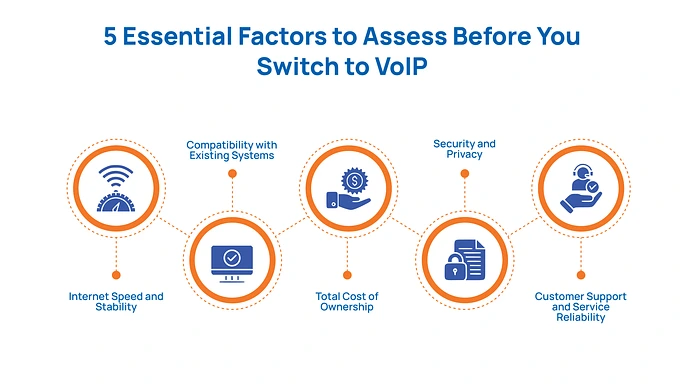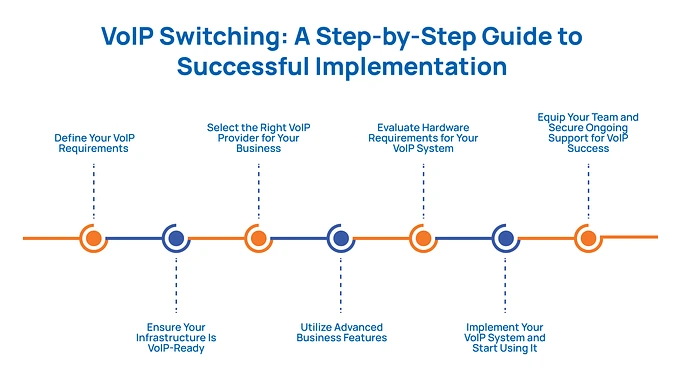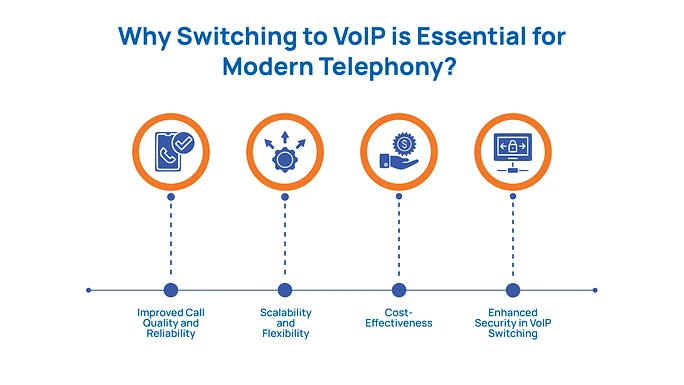Key Takeaways
|
The Evolution of Communication: VoIP vs PSTN Explained
VoIP (Voice over Internet Protocol) is a technology that allows voice communication to be transmitted over the Internet instead of traditional telephone lines. VoIP converts your voice into digital data, which is then sent over the internet to the receiver's device and converted back into sound. Here’s how VoIP works:- Voice Conversion: When you speak, your voice is converted into data (digital packets).
- Transmission: These packets are sent over the Internet to the recipient.
- Data Reassembly: The recipient’s device receives the packets and turns them back into audio so they can hear your voice.
Difference Between Traditional Phone Systems (PSTN) and VoIP
-
Technology
-
Cost
-
Flexibility
-
Quality and Reliability
5 Essential Factors to Assess Before You Switch to VoIP
 VoIP switching refers to directing voice data traffic over the Internet. It is critical in managing and routing VoIP calls between different devices and networks.
When you make a VoIP call, the system must ensure the call is successfully routed from the caller to the recipient through the appropriate channels. VoIP switching handles this task by determining the most efficient path for the voice data to travel over the network. Here are a few essential factors to consider before switching to VoIP.
VoIP switching refers to directing voice data traffic over the Internet. It is critical in managing and routing VoIP calls between different devices and networks.
When you make a VoIP call, the system must ensure the call is successfully routed from the caller to the recipient through the appropriate channels. VoIP switching handles this task by determining the most efficient path for the voice data to travel over the network. Here are a few essential factors to consider before switching to VoIP.
-
Internet Speed and Stability
-
Compatibility with Existing Systems
-
Total Cost of Ownership
-
Security and Privacy
-
Customer Support and Service Reliability
VoIP Switching: A Step-by-Step Guide to Successful Implementation
 Whether you’re a small business or a large enterprise, adopting VoIP requires careful planning and consideration. Here’s what you need to do to transition to VoIP successfully.
Whether you’re a small business or a large enterprise, adopting VoIP requires careful planning and consideration. Here’s what you need to do to transition to VoIP successfully.
-
Define Your VoIP Requirements
-
Ensure Your Infrastructure Is VoIP-Ready
-
Select the Right VoIP Provider for Your Business
-
Utilize Advanced Business Features
| Feature | Description |
| Auto Attendant | Routes incoming calls to the correct department or team member using a phone menu, enhancing professionalism and customer experience. |
| IVR (Interactive Voice Response) | Allows callers to input responses via speech recognition or touch-tone menus, efficiently routing calls to the correct department or individual. |
| Automatic Call Forwarding | It forwards calls to available lines when the primary line is busy, ensuring that VIP clients or important calls aren’t missed. |
| Call Queuing | It eliminates busy signals by placing callers in a queue, allowing them to wait for the next available agent. This reduces call drop-offs and enhances customer satisfaction. |
| Extension Dialing | Allows unique extensions for each department or team, simplifying call routing and ensuring callers reach the correct person directly. |
| Conference Bridge | Facilitates conference calls without long-distance charges. Some providers also include video calling for easier collaboration. |
| VoIP Number Porting | Allows businesses to keep existing phone numbers when switching to VoIP, ensuring no confusion for customers during the transition. |
-
Evaluate Hardware Requirements for Your VoIP System
-
Implement Your VoIP System and Start Using It
-
Equip Your Team and Secure Ongoing Support for VoIP Success
Why Switching to VoIP is Essential for Modern Telephony?
 Here’s why VoIP switching matters in modern communication:
Here’s why VoIP switching matters in modern communication:
-
Improved Call Quality and Reliability
-
Scalability and Flexibility
-
Cost-Effectiveness
-
Enhanced Security in VoIP Switching
Streamline Operations and Improve Customer Engagement with PerfectSoft.AI
 At PerfectSoft.AI, we deliver intelligent, high-performance contact center solutions to improve customer satisfaction, boost agent productivity, and streamline operations.
Whether you manage a large-scale BPO, a customer service department, or an outbound sales team, our technology helps you stay connected across all channels while ensuring crystal-clear
We provide advanced VoIP-based Telecom Voice Services that guarantee:
At PerfectSoft.AI, we deliver intelligent, high-performance contact center solutions to improve customer satisfaction, boost agent productivity, and streamline operations.
Whether you manage a large-scale BPO, a customer service department, or an outbound sales team, our technology helps you stay connected across all channels while ensuring crystal-clear
We provide advanced VoIP-based Telecom Voice Services that guarantee:
- High-Quality Voice Calls – Clear and uninterrupted voice communication.
- Reliable Connectivity – Stable and secure connections across all regions.
- Global Reach – Seamless communication with teams and customers worldwide.


Comments